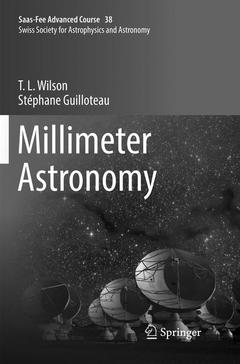Description
Millimeter Astronomy, Softcover reprint of the original 1st ed. 2018
Saas-Fee Advanced Course 38. Swiss Society for Astrophysics and Astronomy
Saas-Fee Advanced Course Series, Vol. 38
Authors: Wilson T. L., Guilloteau Stéphane
Coordinators: Dessauges-Zavadsky Miroslava, Pfenniger Daniel
Language: English
Subjects for Millimeter Astronomy:
89.66 €
In Print (Delivery period: 15 days).
Add to cartPublication date: 02-2019
Support: Print on demand
126.59 €
In Print (Delivery period: 15 days).
Add to cartPublication date: 07-2018
Support: Print on demand
Description
/li>Contents
/li>Biography
/li>Comment
/li>
The millimeter and sub-millimeter wavebands are unique in astronomy in containing several thousands of spectral lines of molecules as well as the thermal continuum spectrum of cold dust. They are the only bands in the electromagnetic spectrum in which we can detect the molecular gas reservoir for star formation and cold dust far away in high-redshift galaxies, and nearby in low-temperature cocoons of protostars and protoplanets.
This book is based on and extensively updated from the lectures given during the Saas-Fee Advanced Course 38 on millimeter astronomy. It presents both the observing techniques and the scientific perspectives of observations at millimeter wavelengths, here in particular the star and planet formation.
The chapters by Thomas L. Wilson and Stéphane Guilloteau have been edited by Miroslava Dessauges-Zavadsky and Daniel Pfenniger. The book is part of the series of Saas-Fee Advanced Courses published since 1971. The targeted audience are graduatePhD and advanced undergraduate students, but the book also serves as reference for post-doctoral researchers or newcomers to the field.About the Authors:
Thomas L. Wilson was on staff at Max-Planck-Inst. f. Radioastronomie from 1969-2004. During this time, he was sent to Arizona as Director of the Sub-mm Telescope Observatory (1997-2002). After this, he was Project Scientist (2004-6), Associate Director (2006-8) and at European Southern Observatory, and subsequently Senior Scientist at ALMA (Atacama Large Mm/sub-mm Array), from Feb 2009 to March 2010. From April 2010 to December 2015, he was at the Naval Research Laboratory, then the NSF Division of Astronomical Sciences, working in the Spectrum Management Unit. Since December 2017 he has an emeritus position with the Max-Planck-Institute for Radioastronomie in Bonn.
Stéphane Guilloteau is "Directeur de Recherche de classe exceptionnelle at CNRS" in Bordeaux. He graduated from the Ecole Normale Supérieure de Paris. He was recruited at CNRS in 1980, just after the creation of an Astrophysics Group at Université de Grenoble. In 1987, he became project scientist of the IRAM interferometer, and later, deputy director of IRAM. He worked on the conception and design of ALMA as Project Scientist between 1999 and 2003. He then joined the Université of Bordeaux. In 1989, he received the "Young Scientist" prize of the Société Française d’Astronomie et d'Astrophysique.
About the Editors:
Miroslava Dessauges-Zavadsky graduated in Physics from the University of Lausanne. She got her PhD in Astrophysics from the University of Geneva after having benefited from a two-years doctoral studentship at the European Southern Observatory in Munich. Then she came back to the Geneva Observatory as a post-doctoral fellow. Since 2010, she has there a permanent position as a scientific collaborator in the extragalactic group and as a local expert in millimeter wavelength observations.
Daniel Pfenniger is Professor of Extra-Galactic Astrophysics at Geneva Observatory, the Astronomy Department of University of Geneva. He stud




